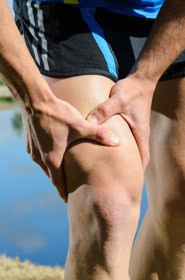Runner’s Knee (Patellofemoral Pain Syndrome) is a frustrating musculoskeletal condition experienced at some time or another by a large proportion of the active population. The term is a little misleading as it is also experienced by people other than runners.
The symptoms include:
- Pain on the anterior aspect (front) of the knee.
- Tends to affect active people especially those who also sit at a desk for long periods.
- May occur in one or both knees.
- Pain is often described as aching. It can be quite severe and may be intermittent.
- Stiffness after a long period sat down, referred to as ‘moviegoers sign’.
- Difficulty walking down stairs.
- Clicking and grinding noise on movement (crepitation).
- Not normally associated with swelling or bruising.
- Knee stiffness but normal range of movement and no locking.
- Pain may be elicited by carrying out squat exercises.
- Often coincides with a step-up in training, especially starting hill running.
There is no real agreement on the definition and classification of this condition. There is debate as to what tissues are involved and what the main cause is. The most widely accepted theory suggests that the symptoms are the result of excessive joint stress due to abnormal movement of the knee-cap but it is likely to involve more than this. At the muscle clinic we commonly find patterns of muscle imbalance and dysfunction associated with Runners Knee that extend beyond the knee joint.
The knee-cap, or patella, is a free bone that ‘floats’ above the end of the thigh bone (femur). It is stabilised and held in position by the thigh muscles (quadriceps). The underside of the patella has a grooved surface that aligns with a guiding track on the femur; the patella glides along this track when the knee bends. If for any reason the patella is derailed from this track, even by a small amount, it doesn’t glide along as it should and it causes the symptoms associated with Runners Knee.
What causes the patella not to track properly?
The quadriceps, as the name suggests, consists of four muscles. An imbalance in these muscles can pull the patella slightly out of alignment as they contract causing the patella to track incorrectly.
The body is a complex structure and reducing it to individual components often leads to an oversimplification of the problem – a mistake even professional researchers make.
The leg bone’s connected to the knee bone,
The knee bone’s connected to the thigh bone,
The thigh bone’s connected to the hip bone,
Now shake dem skeleton bones!
The old children’s song is true; the entire body is connected and any treatment must recognise this. Just massaging the knee and leg isn’t going to solve this problem. Faulty hip mechanics are recognised as being linked to this condition although it is unclear if this is a cause or an effect of runners knee. There is growing evidence to support the association of gluteal muscle weakness in individuals with runners knee and the effectiveness of gluteal strengthening when treating the condition. The gluteus medius is one of the main stabilisers of the hip. When it’s under-active the opposite quadratus lumborum (QL) becomes overactive, often causing low back pain and stiffness. If the gluteus medius is weak, the tensor fascia lata (TFL) will also substitute, causing it to become short, tight and painful to touch. The other areas that may need working on include the iliotibial band, the iliopsoas and possibly the piriformis.
Muscles are very gregarious and like to join in the party! Sometimes the original problem can resolve but still leave traces in the misbehaviour of other muscles.
Every individual will present with a slightly different pattern of muscle dysfunction and it is important to differentiate between a variety of other related conditions that present with knee pain such as iliotibial band syndrome (ITBS), bursitis, plica syndromes, Sinding Larsen’s disease and Osgood Schlatter’s disease. Successful treatment of Runners Knee involves a thorough examination and assessment followed by an entire treatment protocol involving the release of tight muscle, and strengthening of weak muscle. Mobilisations, tractions, massage, stretches and exercises will be an important part of the treatment.
Self Help
- Reduce intensity of training.
- Avoid running over hilly terrain until the condition clears up.
- If you work at a desk ensure you get adequate breaks and don’t miss an opportunity to stand up, stretch and move around.
- Stretch your calf, thigh and hamstring of the affected leg.
- The runner may also want to experiment with slightly reducing their stride length.
Research and further reading
The Role of Hip Muscle Function in the Treatment of Patellofemoral Pain Syndrome
Hip Abductor Weakness in Distance Runners with Iliotibial Band Syndrome
Gluteal muscle activity and patellofemoral pain syndrome: a systematic review
Patellofemoral pain syndrome : Clinical and pathophysiological considerations
A retrospective case-control analysis of 2002 running injuries

